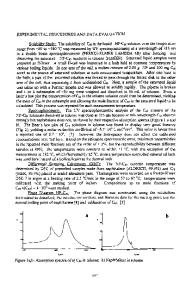Thermo-Calc Determination of Phase Diagram of Si-B Binary System
- PDF / 1,282,634 Bytes
- 7 Pages / 593.972 x 792 pts Page_size
- 98 Downloads / 308 Views
https://doi.org/10.1007/s11837-020-04467-z Ó 2020 The Minerals, Metals & Materials Society
SILICON PRODUCTION, REFINING, PROPERTIES, AND PHOTOVOLTAICS
Thermo-Calc Determination of Phase Diagram of Si-B Binary System SHADIA J. IKHMAYIES
1,2
1.—Jabal El-Hussain, Amman 11121, Jordan. 2.—e-mail: [email protected]
Deep understanding of the Si-B binary system is mainly essential for producing solar-grade silicon from metallurgical-grade silicon (MG-Si) as raw material. The phase diagram and thermodynamic properties are the main pillars of this understanding, where the phase diagram is useful for determining the Si terminal solubility, which is necessary for the success of the solvent refining process, by careful examination of the solvus line. Since Si-B phase diagrams found in literature are old and based on old experimental data, Thermo-Calc software 2019b is used in this work to reassess the temperature–composition phase diagram of the Si-B binary system at pressure of 1 bar. The resulting phase diagram is compared with experimental and computed diagrams found in literature and used to deduce the different reactions, melting temperatures, and solubilities of Si in B and B in Si, and all the identified discrepancies are discussed. There are six single phases other than elemental boron and elemental silicon: liquid, diamond-Si solid solution, b-B solid solution, SiB3 solid solution, SiB6 considered as a stoichiometric compound, and SiBn solid solution. In addition, the phase diagram includes nine regions of two mixed phases, all of which are thoroughly discussed. The melting points of pure b-B and pure diamond-Si are determined. Two peritectic reactions are found, a eutectic reaction, and a peritectoid reaction. The maximum solubility of Si in B is found to be 5.37 Si mass percent at 2310.04 ± 0.025 K, while that of B in Si is found to be 0.41 B mass percent at 1657.56 ± 0.025 K.
INTRODUCTION Understanding the phase diagrams of binary and ternary systems including silicon is essential because solar cell silicon, known as solar-grade silicon (SoGSi), should have high purity of at least 99.9999%, mainly being prepared from metallurgical-grade silicon (MG-Si) as a raw material. The MGSi melt contains many impurity elements such as Fe, Al, Ca, Ti, P, B, C, O, etc., and the presence of some of these impurities affects the properties and thus performance of Si solar cells.1 The phase diagrams of some of these Si binary systems were reassessed by the author of this work.2–5 As one of the Si systems, the B-Si system is very important, because B is used as a dopant to produce p-type Si for the manufacture of semiconductor devices6 as well as Si (Received June 15, 2020; accepted October 23, 2020)
photovoltaic (PV) cells. Despite this fact, the presence of B in Si as an impurity negatively affects the photoelectric conversion efficiency of SoG-Si.7,8 This occurs because very small and precisely determined quantities of B are used as dopants for photovoltaic components. Therefore, the presence of B as an impurity is
Data Loading...











